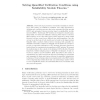1629 search results - page 313 / 326 » A Framework for Designers to Support Prospective Design |
SIGSOFT
2008
ACM
14 years 8 months ago
2008
ACM
Developers perform small-scale reuse tasks to save time and to increase the quality of their code, but due to their small scale, the costs of such tasks can quickly outweigh their...
SIGSOFT
2008
ACM
14 years 8 months ago
2008
ACM
Program specifications are important for many tasks during software design, development, and maintenance. Among these, temporal specifications are particularly useful. They expres...
CHI
2009
ACM
14 years 8 months ago
2009
ACM
Contemporary work increasingly involves interacting with strangers in technology-mediated environments. In this context, we come to rely on digital artifacts to infer characterist...
POPL
2007
ACM
14 years 7 months ago
2007
ACM
ML modules and Haskell type classes have proven to be highly effective tools for program structuring. Modules emphasize explicit configuration of program components and the use of...
CADE
2007
Springer
14 years 7 months ago
2007
Springer
Abstract. First order logic provides a convenient formalism for describing a wide variety of verification conditions. Two main approaches to checking such conditions are pure first...

